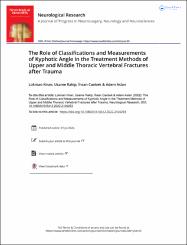| dc.contributor.author | Kıran, Lokman | |
| dc.contributor.author | Rakip, Usame | |
| dc.contributor.author | Canbek, İhsan | |
| dc.contributor.author | Aslan, Adem | |
| dc.date.accessioned | 2022-08-02T06:40:25Z | |
| dc.date.available | 2022-08-02T06:40:25Z | |
| dc.date.issued | 31.07.2022 | en_US |
| dc.identifier.issn | 1743-1328 | |
| dc.identifier.uri | https://doi.org/10.1080/01616412.2022.2104293 | |
| dc.identifier.uri | https://hdl.handle.net/20.500.12933/1392 | |
| dc.description.abstract | BACKGROUND AND AIM Thoracic fractures can lead to death and disability. This retrospective study aimed to evaluate cases of upper and middle thoracic vertebral fractures due to trauma that had been treated, to determine the fracture type and treatment method according to age, sex, cause of injury, neurological status, fracture level, kyphotic angles, and classification methods and to discuss the results regarding that reported in the literature.
PATIENTS AND METHODS This study included 238 patients who were evaluated for post-traumatic upper and middle thoracic vertebral fractures between January 2012 and December 2020. We classified each patient according to the Dennis, TLICS, ATLICS, and ASIA classifications using neurological examination, radiography, computed tomography, and magnetic resonance imaging. We statistically evaluated the data obtained.
RESULTS Fifty-five percent of total patients were male. The average age was 51.11. Traffic accidents were the most common causes of trauma, with 67.2%. T8 was most affected. The ASIA classification, the Dennis, TLICS, and ATLICS classifications showed a significant increase in the severity of neurological deficits as the fracture scores increased (p < 0.001). We observed that the increase in the preoperative kyphotic angle caused an increase in the number of deficits according to the classifications (p < 0.001).
CONCLUSION The ATLICS classification yielded more accurate results than that of the other classifications. In addition, the kyphotic angle was evaluated for upper and middle thoracic fractures, and we concluded it is important in surgical decision making. | en_US |
| dc.language.iso | eng | en_US |
| dc.publisher | Taylor & Francis Group | en_US |
| dc.relation.isversionof | 10.1080/01616412.2022.2104293 | en_US |
| dc.rights | info:eu-repo/semantics/embargoedAccess | en_US |
| dc.subject | Thoracic vertebra | en_US |
| dc.subject | Fracture | en_US |
| dc.subject | AO spine | en_US |
| dc.subject | TLICS classification | en_US |
| dc.subject | Kyphotic angle | en_US |
| dc.title | The Role of Classifications and Measurements of Kyphotic Angle in the Treatment Methods of Upper and Middle Thoracic Vertebral Fractures after Trauma | en_US |
| dc.type | article | en_US |
| dc.authorid | 0000-0001-7494-0335 | en_US |
| dc.authorid | 0000-0001-7740-196X | en_US |
| dc.authorid | 0000-0001-9432-5399 | en_US |
| dc.department | AFSÜ, Tıp Fakültesi, Cerrahi Tıp Bilimleri Bölümü, Beyin ve Sinir Cerrahisi Ana Bilim Dalı | en_US |
| dc.contributor.institutionauthor | Rakip, Usame | |
| dc.contributor.institutionauthor | Canbek, İhsan | |
| dc.contributor.institutionauthor | Aslan, Adem | |
| dc.identifier.startpage | 1 | en_US |
| dc.identifier.endpage | 7 | en_US |
| dc.relation.journal | NEUROLOGICAL RESEARCH | en_US |
| dc.relation.publicationcategory | Makale - Uluslararası Hakemli Dergi - Kurum Öğretim Elemanı | en_US |
















